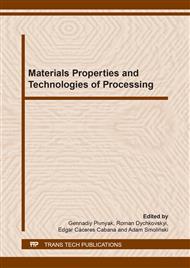p.110
p.121
p.131
p.137
p.148
p.155
p.173
p.183
p.193
Mathematic Model and Method for Solving the Heat-Exchange Problem in Electron-Beam Welding of Arbitrary Areas
Abstract:
For the first time in this article, a mathematical model has been developed for calculating the temperature fields in arbitrary areas in electron-beam welding; this model was created in the form of a boundary value problem of mathematical physics for a parabolic equation of heat conductivity with Dirichlet boundary conditions. A new integral transformation was constructed for a two-dimensional finite space, with the use of which, as well as the finite element method and Galerkin's method, a temperature field has been determined in the form of a convergent series.
Info:
Periodical:
Pages:
173-182
Citation:
Online since:
May 2019
Authors:
Price:
Сopyright:
© 2019 Trans Tech Publications Ltd. All Rights Reserved
Share:
Citation:


